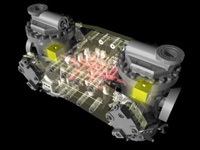Magnetic moment testing of LISA Pathfinder flight-model units
10 November 2009
Flight-model units for the LISA Pathfinder spacecraft are undergoing a series of tests to determine their magnetic characteristics. The purpose of the tests is to ensure that the stringent magnetic cleanliness requirements of the LISA Pathfinder mission will be met.
 |
| Illustration of the LISA Technology Package on LISA Pathfinder which carries the two test masses (each a Gold/Platinum alloy cube of 46 mm on a side and weighing almost 2 kg). Credit: ESA |
The LISA Pathfinder mission objective is to verify that a test mass onboard the spacecraft can be kept 'free-floating', subject to unwanted accelerations of less than
To minimise the magnetic disturbance arising from individual elements careful attention is paid to the selection of materials and tools that are used during the construction process. However, even under the best conditions some residual magnetic field is associated with each unit on the spacecraft.
The purpose of the magnetic moment test programme, which began in June this year and will continue until the end of 2009, is to characterise the magnetic field arising from each unit and to determine that the magnetic cleanliness requirements of the mission will be met.
The tests are being performed using 'Magnetic Coil Facilities' at ESA's European Space Research and Technology Centre (ESTEC), in Noordwijk, the Netherlands, at EADS Astrium Stevenage, in the UK, and at EADS Astrium Friedrichshafen, in Germany.
|
Magnetic moment test programme summary |
||
| Unit | Provided by | Test site |
| Laser Modulator (LM) | RUAG (CH) / APC Université Paris | ESTEC |
| Laser Control Unit (LCU) | Kayser Threde (D) / Max Planck Albert Einstein Institute | ESTEC |
| Inertial Sensor Front End Electronics (IS FEE) | RUAG (CH) / ETH | ESTEC |
| Phase Meter Unit (PMU) | University of Birmingham (UK) / STFC | EADS Astrium Stevenage |
| Charge Management Device (CMD) | Imperial College London (UK) / STFC | ESTEC |
| Data and Diagnostic Subsystem (DDS) | NTE - SENER (E) / CSIC-IEEC | ESTEC |
| Caging Control Unit (CCU) | Thales Alenia Space (I) / ESA | ESTEC |
| Reference Laser Unit (RLU) | Tesat (D) / Max Planck Albert Einstein Institute | EADS Astrium Friedrichshafen |
Upon successful completion of the complete environmental test programme - these magnetic moment tests are amongst the final tests in the programme - the individual units will be delivered to the payload architect, EADS Astrium Friedrichshafen, in order to begin the electrical integration and flat-bed testing campaign.
Contact
Bengt Johlander, LISA Pathfinder Senior Instrument System Engineer
Science and Robotic Exploration Directorate, ESA, The Netherlands.
Email: Bengt.Johlander esa.int
esa.int







